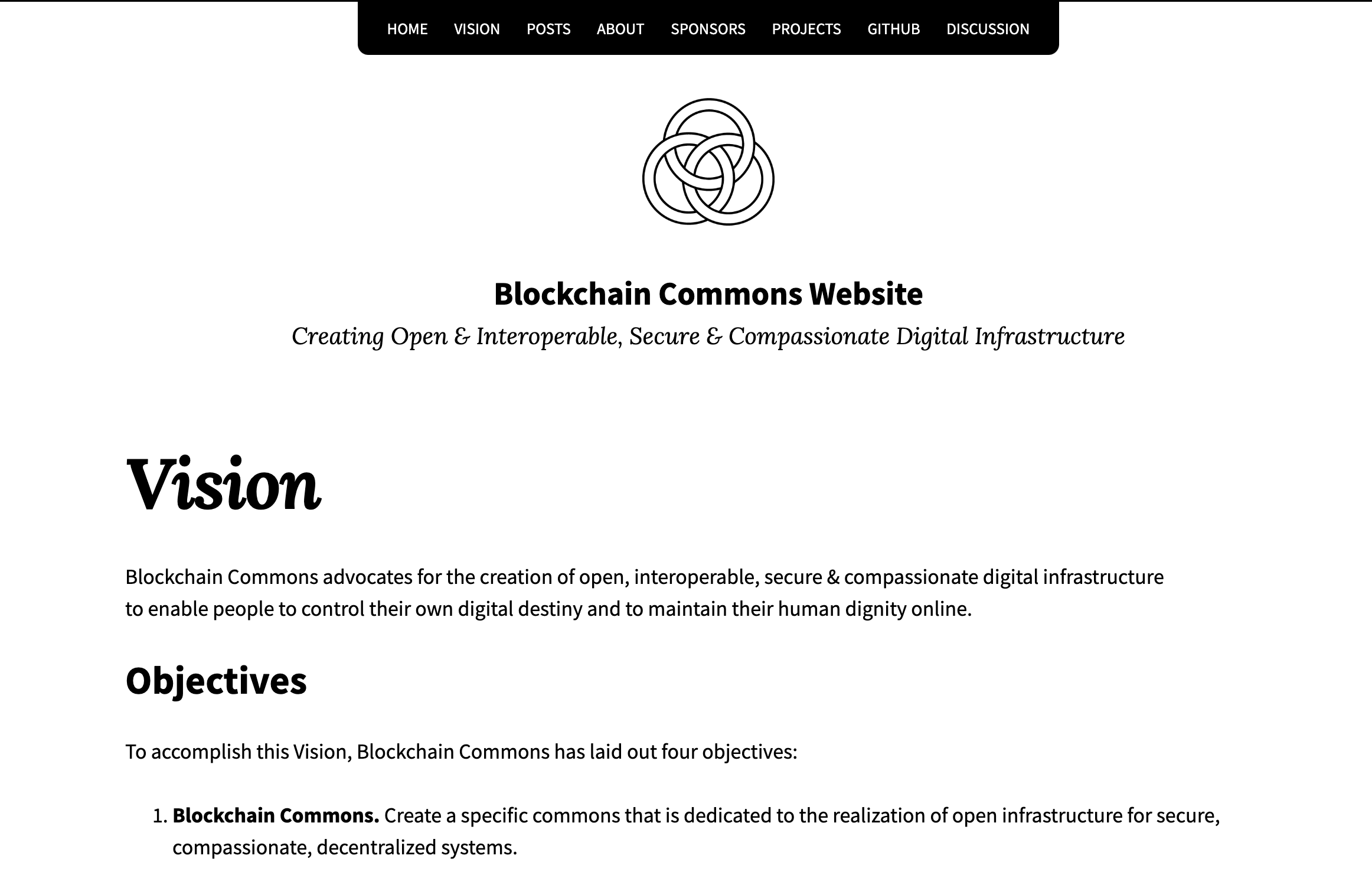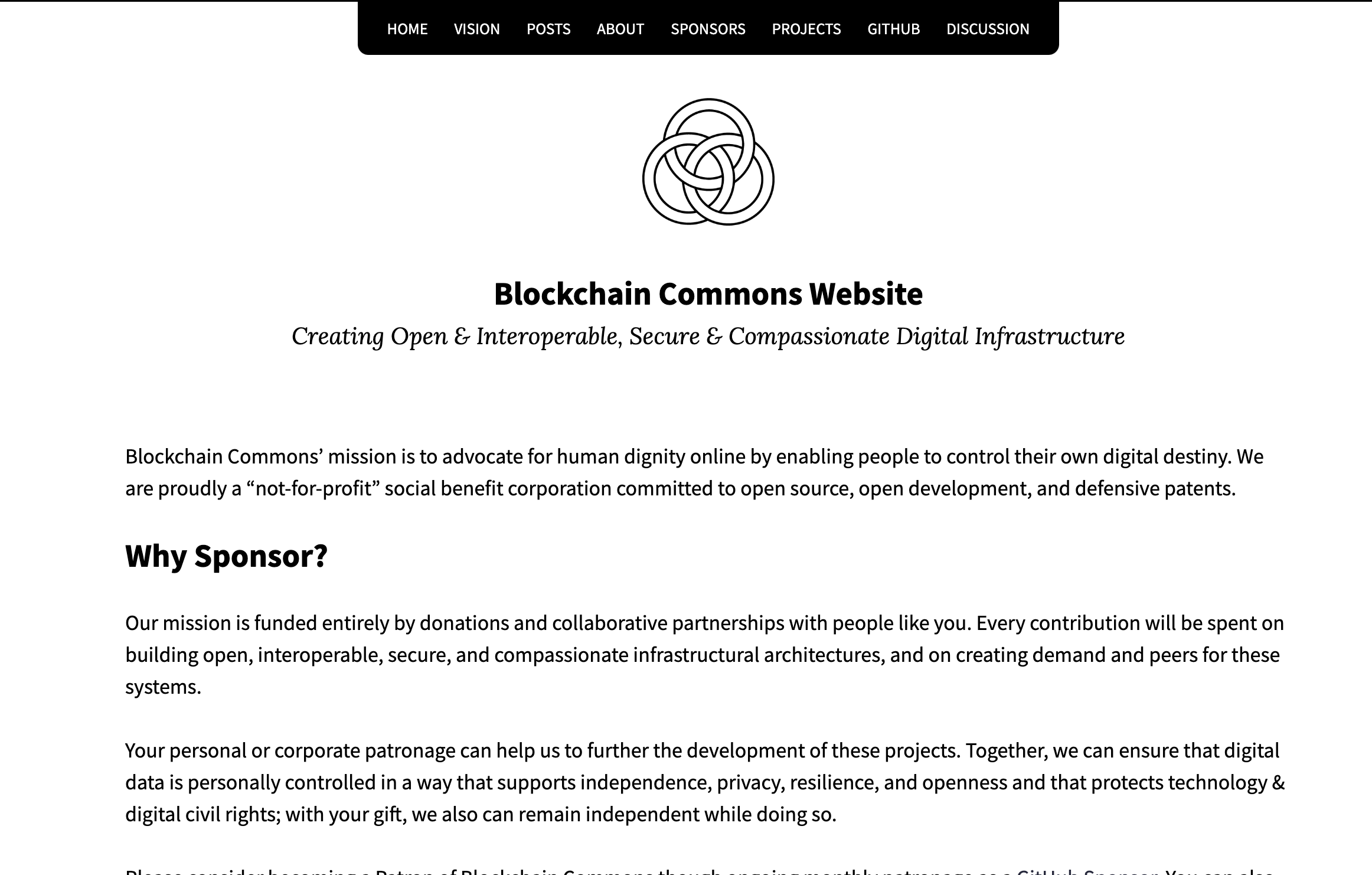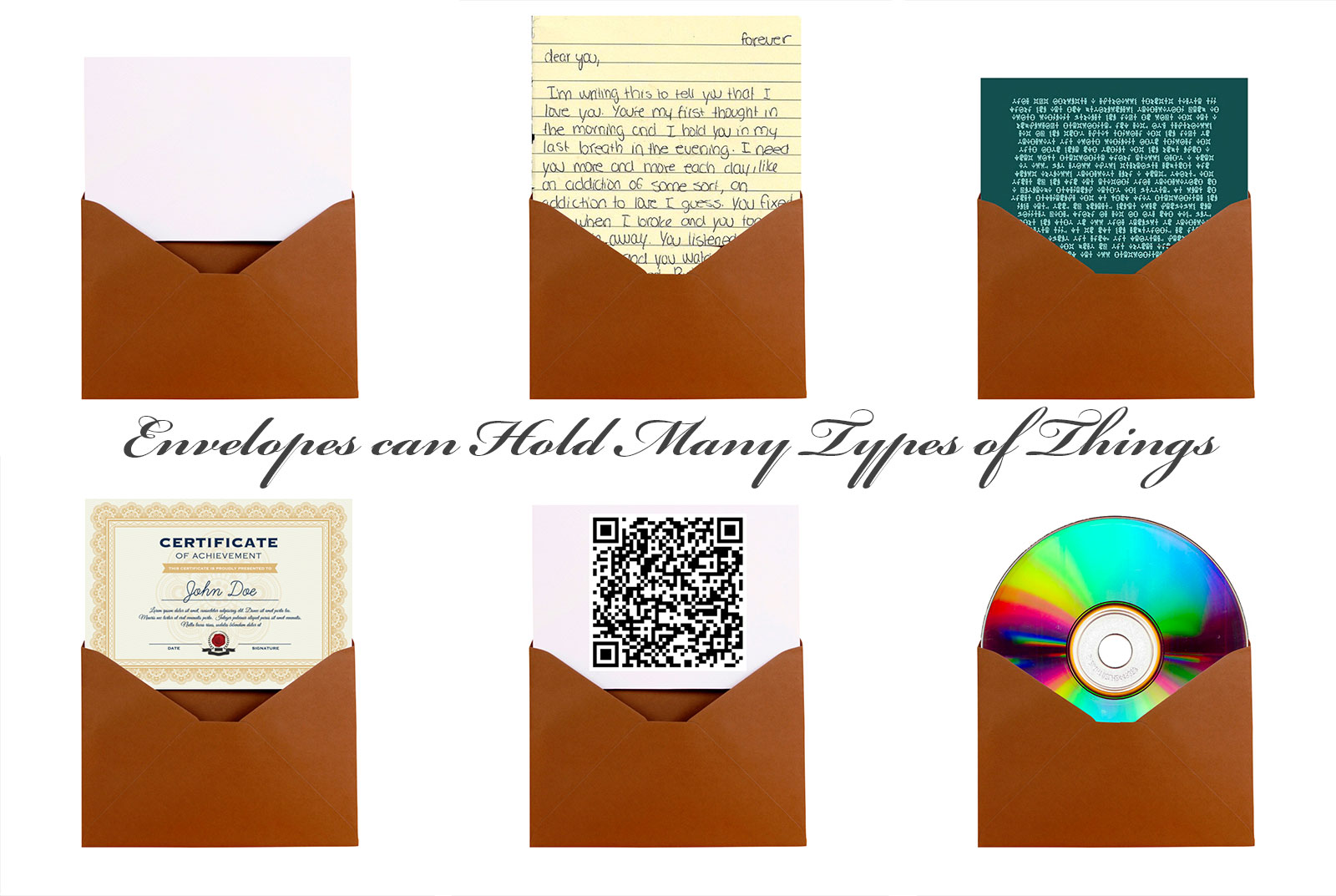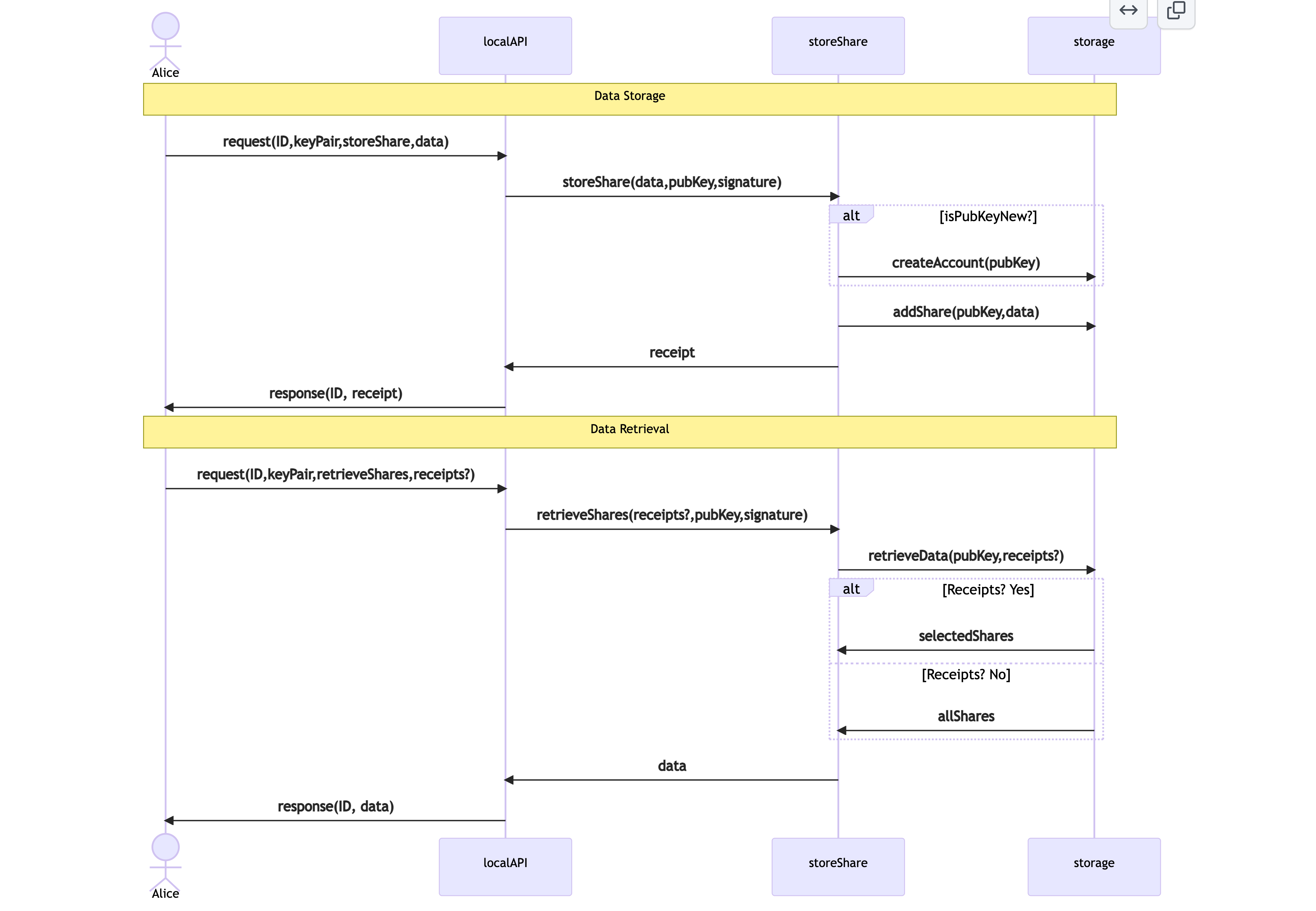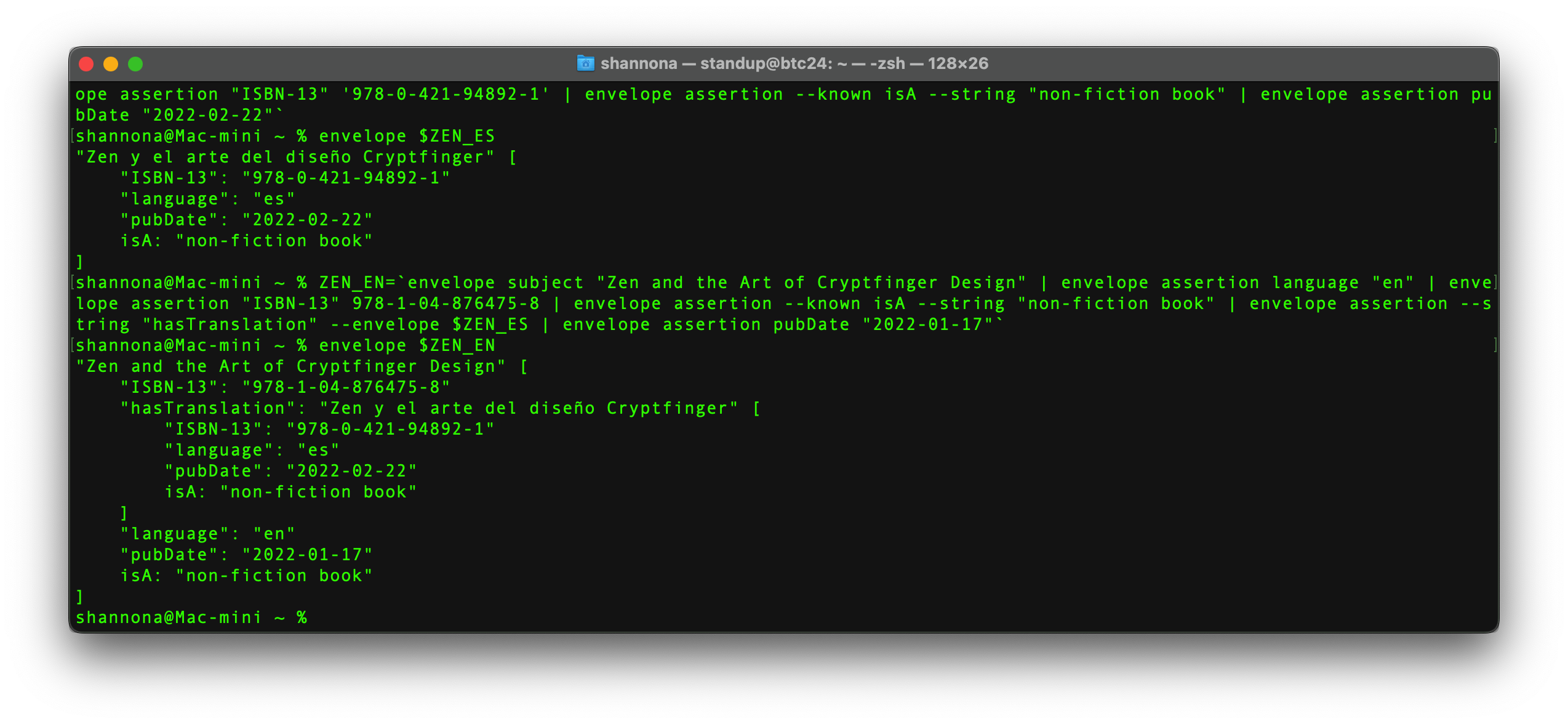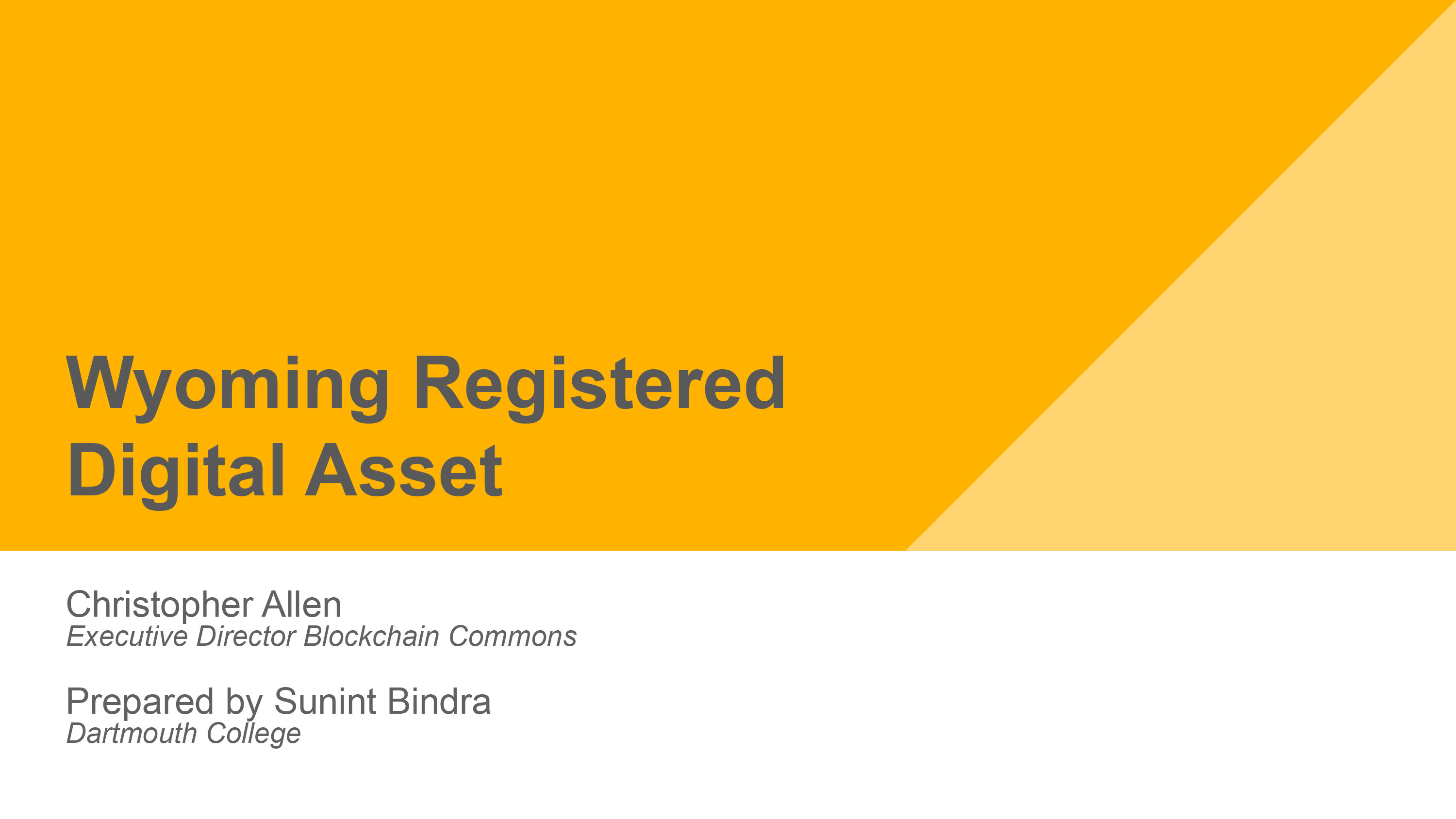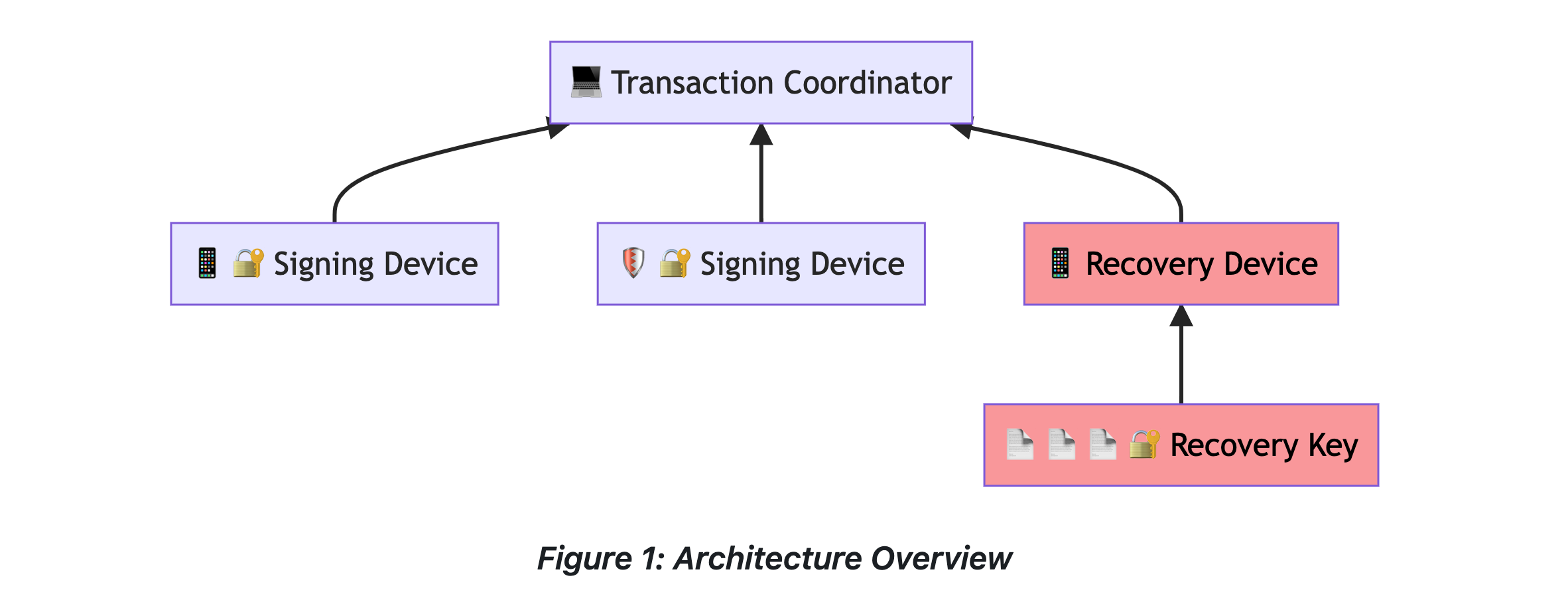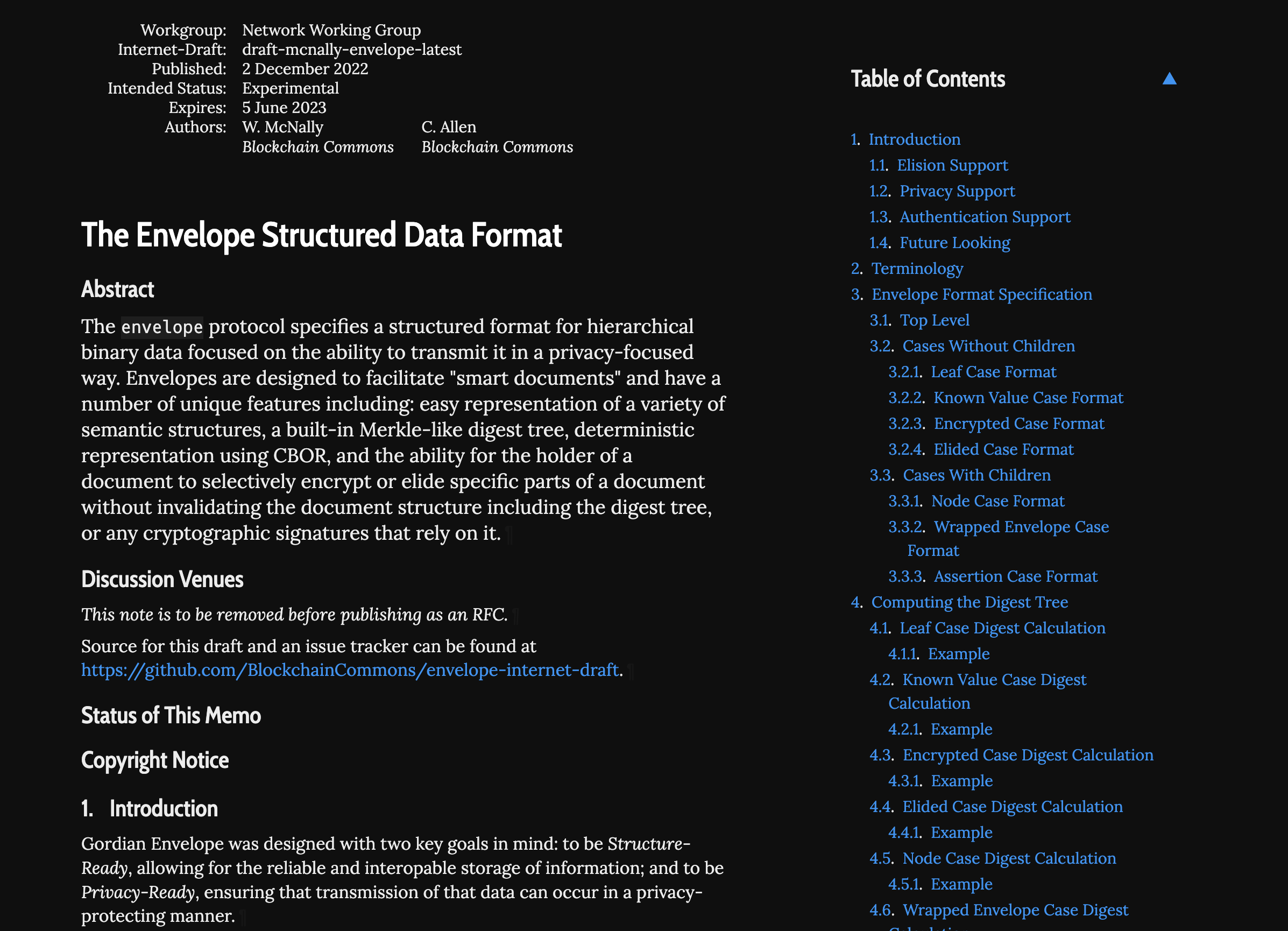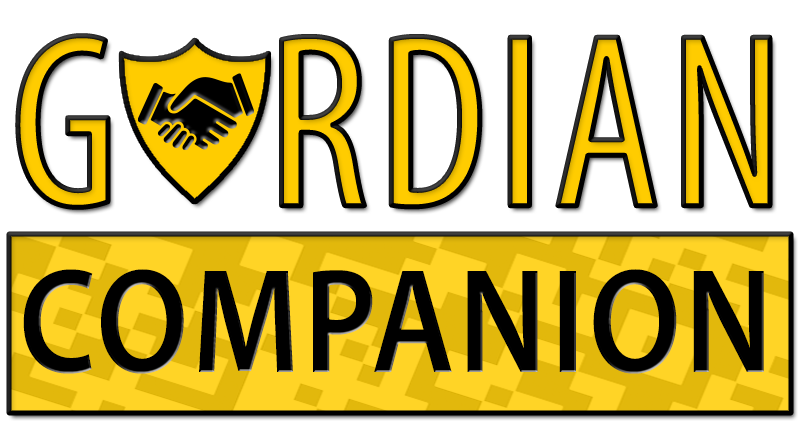Blockchain Commons 2022 Overview
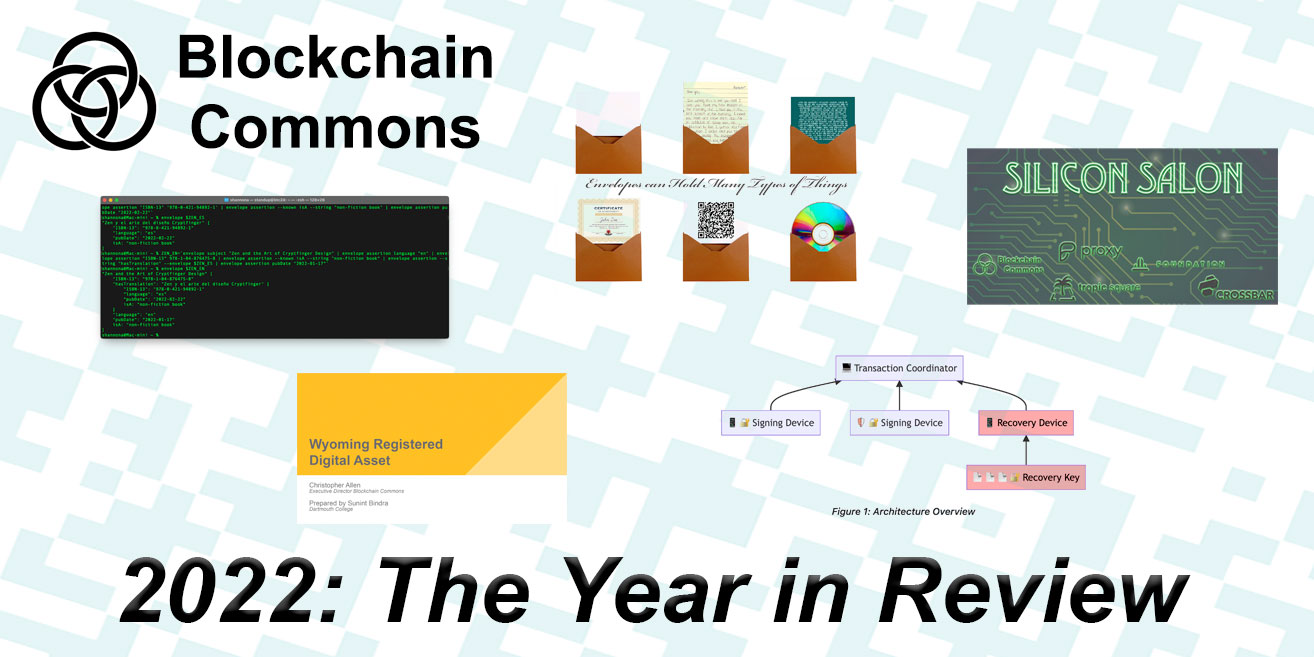
2022 might have been Blockchain Commons’ strongest year ever. Though we laid down much of our foundational architecture a few years ago, we returned this year with one of our most important architectural elements ever: The Gordian Envelope. Meanwhile, our community grew to become the Commons we’d always envisioned.
Here’s an overview of the year:
Our Vision
We expanded our main vision statement last year, so that it now reads:
“Blockchain Commons advocates for the creation of open, interoperable, secure & compassionate digital infrastructure to enable people to control their own digital destiny and to maintain their human dignity online.”
The core is still there: Blockchain Commons advocates for human dignity online, so that we can control our digital destiny. But we’re now more explicit that we expect to reach this goal through the creation of “open, interoperable, secure & compassionate digital infrastructure”. That’s what Blockchain Commons has been working on since its inception, but we wanted to be more clear about why.
Our objectives for reaching this vision have remained the same: creating a commons, designing a self-sovereign architecture, inspiring demand for self-sovereignty through advocacy, and enabling our community of peers. Of those, our work on the Commons and the architecture were our main focus for the year.
Also see our updated Projects page for how everything fits together.
The Commons
We have always imagined a commons of different companies and individuals coming together to jointly create an interoperable architecture that supports the Gordian Principles of independence, privacy, resilience, and openness. Our Gordian Developer Community (formerly the Airgap Wallet Community) has enabled that from the beginning.
In 2022, that community truly matured through the appearance of a number of sponsors who are not only supporting Blockchain Commons but also actively working with us in weekly or biweekly calls and conferences. New faces in 2022 included Chia, CrossBar, and Proxy, who have joined extant sponsors such as Bitmark, Blockchainbird, Foundation, and Unchained Capital.
We’ve also begun reaching out more to the identity community, including at Rebooting the Web of Trust 11, where we collaborated on papers such as “Selective Correlation” (still in process). We hope for even more interaction with identity professionals in 2023.
Silicon Salons
The expansion of our commons has allowed us to bring various members of that community together to share their knowledge and express their requirements. One of the results of this is our Silicon Salons. We held two in 2022: Silicon Salon 1 in June and Silicon Salon 2 in September. At these Salons, hardware-wallet designers and semiconductor manufacturers came together to express their requirements and possibilities.
Silicon Salon 3 is occurring on January 18th. The plan is to continue them throughout 2023 as long as interest holds.
Gordian Envelope
We’ve also been able to work extensively with our community on Gordian Envelope, which we’ve detailed in a whole series of videos.
Gordian Envelope is our most notable new architectural design in a few years. It’s a Smart Document structure that allows for the storage and communication of sensitive data supported by powerful elision, encryption, and variable permit technology.
We introduced Gordian Envelope because we saw the need for a privacy-preserving data format. You can hold credentials and decide what to reveal. You can sign things anonymously, but later connect a real identity to those signatures. You can hide within herd privacy and choose whether your data is ever revealed. We wrote a whole set of use cases that reveal many of the other advantages of Gordian Envelope (such as metadata, selective encryption, and multilock permits).
As part of our Gordian Envelope development, we also released our first MVA cryptosuite, to detail the cryptographic algorithms and architectures we found most useful for Envelope. It’s not our final word on what the best algorithms are currently, or even what we’ll finalize in Envelope, but it’s a great introduction to our current thoughts on the state of crypto-technology.
CSR
Much of our Gordian-Envelope design in 2022 was in service to the work on Collaborative Seed Recovery, or CSR. This is a joint project that we’re working on with Bitmark, Foundation, and Proxy; this shows off another benefit of our growing community, because it allows more thoughtful attention from a variety of stakesholders for a project like this.
CSR is ultimately an application-level program, building on our Envelope architecture. It uses Shamir’s Secret Sharing (and our SSKR implementation) to allow for the sharding of seeds and their automated storage at remote locations. The ultimate goal is to create an interoperable CSR ecosystem where different providers can offer different services, allowing users to independently store their private keys or seeds (or other data) in a resilient and secure way.
We’re certain the result will be an improvement for users because existing procedures, such as the etching of BIP-39 words into metal plates, weren’t being followed by most users, leaving them vulnerable to loss; CSR will assure the resilience of those digital assets, a service that wallet providers will be eager to offer. We know that designers will be interested in interoperable specifications of this type not just because of the benefits they offer to their users, but also because interoperable specifications can reduce developer costs and liability risks and give them a leg up in the industry.
Our Adoption
While Gordian Envelope is still in a relatively early stage of development, we’ve been pleased to see continued adoption of some of our older specifications such as Uniform Resources (URs) and animated QR codes (which are largely a requirement for translating PSBTs into QR codes). It’s a sign of success that we’re no longer entirely sure exactly who’s adopting what, but it looks to us like Sparrow Wallet, Blue Wallet, Keystone Wallet, Casa, Nunchuk, and Blockstream’s Jade Wallet are now all using some part of our UR and/or QR work.
We’re also thrilled to have partners and contributors continue to expand our mature specifications by converting them to new languages. Thanks to Bryan Bishop and Cramium for lifehash-python and to Craig Raw and Sparrow Wallet for toucan, which is lifehash in C/C++.
Our Reference Apps
Blockchain Commons has long seen reference apps as the next stage in our architectural development after specification design. When we’re not working directly with designers (as we are with CSR), our Reference Apps give us a way to demonstrate the usage of our specifications and the best practices of our Gordian Principles to those developers.
We don’t talk as much about our CLI apps as we do our MacOS and iOS apps, but they’re crucial tools for developers to both see the implementation and usage of our specifications. Our most important new app is thus envelope-cli, which demonstrates the real-world usage of Gordian Envelope: all of the current Envelope specifications, including elision and encryption, are already entirely functional. envelope-cli works well with other apps such as bytewords-cli to allow for the testing and development of many of our new specs.
We also continued to update our flagship app, Gordian SeedTool with 1.4.0 and 1.5.0 releases. Most of that focused on experiments with NFC Tags as we continue to explore the best practices for resiliently securing data. Meanwhile, Gordian Server and our related Standup Scripts saw updates to support Bitcoin 23 (and were successfully tested against Bitcoin 24).
That pretty much closes out our architectural work, which was the majority of our attention in 2022, but our objectives of creating demand and generating new peers did get some attention.
Law & Advocacy
Obviously, we and our community can work together to advocate our principles and our specifications to the larger community of cryptographic engineers and designers. But we’ve spent more time working with legislators to try and encapsulate some of the usage and protection of digital assets in law.
Much of that continues to be focused on Christopher’s personal relationship with the Wyoming legislature. This year, that included support for e-residency and advocacy for Wyoming Registered Digital Assets. However, our biggest push has been for the protection of private keys in judicial venues, a battle that continues to be crucial in 2023.
By working to legally support digital assets with programs like e-residency and WRDAs and to protect them, we can create an environment where a resilient, private, open, and independent digital ecosystem isn’t just a nice idea, but the expectation: that’s what we mean when we say that we’re creating demand for the principles that we advocate.
Our Peers Program
Finally, our program of bringing new peers into the industry has long focused on our two major education programs, Learning Bitcoin from the Command Line and #SmartCustody. We weren’t able to give them a lot of attention this year, primarily because we haven’t been able to find sponsors interested in expanding these crucial programs. (If that’s actually you, contact us at team@blockchaincommons.com!)
Nonetheless, #SmartCustody got a bit of expansion early in the year, the most important of which was a new multisig scenario. Just five years ago, when we started work on #SmartCustody, self-sovereign multisig was still a pipe dream, so it’s thrilling that five years later we can offer it to sophisticated users. (Unfortunately, it’s still somewhat complex, though we think specifications like our crypto-request could resolve that.) We’ve also started writing some case studies examining how second-generation digital wallets fulfill the Gordian principles.
The other major element of our peers objective has been our internship program, which ran for its third year this summer. We got good support from interns in some of our projects, particularly during the summer session in Wyoming, and hope we were able to provide them with experience that will be valuable in the future.
The Future of Gordian Envelope
For the moment we’re pausing in our foundational design work on Gordian Envelope, as we have the core specification, software, and most crucial documentation in place. That means that we’re now in a place where we need feedback on the current specification before we take the next step.
We hope to gain some of that from international standards organization such as IETF or W3C, or foundational specification organizations such as DIF or the Linux Foundation, who we hope will take up Envelope in the next year. These are organizations that can offer vital feedback on topics such as our MVA Algorithms. Our first presentation is to the W3C Credentials Community Group, on January 31st.
Ideally, standards organizations could even develop our specification as a standard, which would make the adoption of Envelope by companies much easier. Obviously, any standardization would be an elongated process. If we don’t see a full adoption of the specification by an international standards organization, we’d at least like to see standards organizations begin to mandate usage of hash-based elision, as we’re aware of other proposals for that privacy function.
Another way that we can receive feedback during this period is via an independent third-party security review. We hope to lead the community in funding such a review this year.
After this brief pause, there’s lots more we’d like to do with Gordian Envelope, such as introducing Self-certifying IDs (SCIDs) and better supporting a variety of structured formats. We just need to lock the foundation of Envelope down first, and then there’s a variety of interesting and useful things that we can do with it next.
The Future of Other Architectural Work
Blockchain Commons is not a standards organization ourself: our foremost goal is to meet the goals of our vision, creating “open, interoperable, secure & compassionate digital infrastructure”. However, we recognize the advantages of standardization to businesses, and so we’d also like to see our older UR work picked up as a BIP and/or ERC.
To further support business, we’d also like to offer some conformance testing for our UR designs (and for Envelope for that matter), so that companies can announces when they’re doing work that meets the best practices of our most current specifications.
Meanwhile, a lot of our Envelope work was in service to CSR, so our next goal is to see that finalized. That primarily means supporting our partners to enable their debut releases of CSR, both technologically and by expanding the options they’re considering for sharding scenarios. We hope to see the first releases of CSR in Q1 or Q2. We also plan to create a reference app of our own, called Gordian Companion, which can be used to store other peoples’ SSKR shares; besides producing a mobile app, we also hope to create a Tor-enabled web service.
Our goal with reference apps is always to show developers the possibilities of our specifications and some best practices for their deployment, and that speaks to our long-term goal for CSR: passing development on to a variety of developers. By the end of the year, we hope to have at least two interoperable versions of CSR, released by two different companies (other than Blockchain Commons). Moreso, we’d like to see a real diversity of companies working in this space, including not just traditional wallet companies, but also identity companies, protected communication companies, and more.
We’ve primarily focused on MacOS and iOS to date for our reference apps and their reference libraries, with some support from our partners in creating Android conversions. We hope to be expanding our own ability to support Android in the next year by porting all of our reference code to Rust, beginning with Gordian Envelope.
Beyond that, there’s definitely new cryptographic ground to cover. Taproot and Schnorr are now increasingly mature. We also want to do more investigation of zero-knowledge proofs, Multiparty Computation (MPC), verkle trees, and cryptographic circuits. Unfortunately, these technologies aren’t quite ready for widespread usage yet, and so it’s putting a hold on some initiatives.
That includes Collaborative Key Management or CKM, which allows for not just the distributed storage of keys, but their distributed usage as well. CKM is much more cutting-edge technology than CSR, since it depends on the new field of MPC so it’s one of the topics that’s awaiting continued expansion in the field.
The Future of Other Objectives
Beyond our continuing and new architectural work, we expect to continue supporting our other programs.
For Silicon Salon, that means quarterly salons, tentatively scheduled for January, April, July, and October, each with 3-5 presentations followed by facilitated conversation. The turnaround on silicon design is slow, so this is by necessity something that we’re supporting over a long haul. Though we hope to see current chips integrating with new hardware to support specifications like Lifehash and UR in 2023, it’ll be at least 2024 before we see tapeouts of chips influenced by the Salons, thanks to real semiconductor manufacturers reacting to the real requirements of hardware-wallet companies. Nonetheless, we’re eager to see what that future brings!
Meanwhile, a lot of our continued advocacy comes courtesy of our early self-sovereign identity work. We expect to continue that in 2023, including more work in Taiwan, in Europe, and elsewhere. For Europe in particular we’re seeing problems with over-identification, where regulations are encouraging people to use the most intrusive forms of identification possible (which usually means biometrics) and to overcentralize. Simultaneously, the EU is going to be making huge decisions about identity wallets in the next year or two. We are supporting a variety of European parties who are concerned with all of these elements.
We are also, of course, continuing our work in Wyoming. We hope to see two notable bills this year, one on private-key protection and another on digital-asset registration, though we’re not entirely sure whether they’ll reach the agenda for discussion or not. if they do, and if they pass, we’ll need to do additional work to support them afterward.
For Smart Custody, we’re unfortunately blocked because of the speed of technological development, including incomplete deployments of multisigs and over on Ethereum, unfinished work on account abstractions. On the other hand, we’re right on the verge of larger MPC (Multi-Party Computation) deployments such as Schnorr-based FROST & ElGamal-based ECDSA threshold signatures. So, we foresee exciting futures for Smart Custody, but aren’t quite sure when we’ll be ready to dive in.
Overall, there are plenty of new technological possibilities for Blockchain Commons going into 2023, from the pragmatic completion of our tasks in progress to the imaginative innovation of the cryptographic future.
Meanwhile, we’d love to bring in more partners, though we’re aware that can be difficult in a potentially recessionary year. But often the best investments can be made when the market is down, and so we encourage our potential partners to consider that for 2023. The larger our community, the more we can ensure that everyones’ requirements are met, and the better we can release interoperable systems that will benefit everyone!
Our Thanks
Ultimately, it’s community that makes Blockchain Commons work: though we are advocating for personal control and independence, we can only get there together. So thank you for all the contributions to Blockchain Commons in time, money, and expertise from both individuals and companies; and thank you for your interest in self-sovereignty and our principles of privacy, independence, resilience, and openness. Together we can do this!
Christopher Allen
Principal Architect & Executive Director
Blockchain Commons
